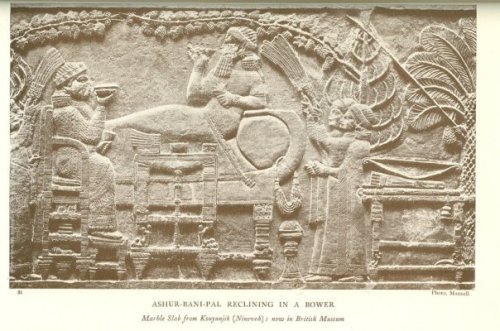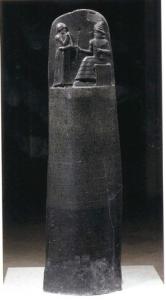” … Pir-napishtim made answer, reminding the pilgrim that all men must die. Men built houses, sealed contracts, disputed one with another, and sowed seeds in the earth, but as long as they did so and the rivers rose in flood, so long would their fate endure. Nor could any man tell when his hour would come. The god of destiny measured out the span of life: he fixed the day of death, but never revealed his secrets.
Gilgamesh then asked Pir-napishtim how it chanced that he was still alive. “Thou hast suffered no change,” he said, “thou art even as I am. Harden not thy heart against me, but reveal how thou hast obtained divine life in the company of the gods.”
Pir-napishtim thereupon related to his descendant the story of the deluge … The gods had resolved to destroy the world, and Ea in a dream revealed unto Pir-napishtim how he could escape. He built a ship which was tossed about on the waters, and when the world had been destroyed, Bel discovered him and transported him to that island in the midst of the Sea of Death.
Gilgamesh sat in the boat listening to the words of his ancestor. When the narrative was ended, Pir-napishtim spoke sympathetically and said: “Who among the gods will restore thee to health, O Gilgamesh? Thou hast knowledge of my life, and thou shalt be given the life thou dost strive after. Take heed, therefore, to what I say unto thee. For six days and seven nights thou shalt not lie down, but remain sitting like one in the midst of grief.”
Gilgamesh sat in the ship, and sleep enveloped him like to a black storm cloud.
Pir-napishtim spoke to his wife and said: “Behold the hero who desireth to have life. Sleep envelops him like to a black storm cloud.”
To that lone man his wife made answer: “Lay thine hand upon him so that he may have perfect health and be enabled to return to his own land. Give him power to pass through the mighty door by which he entered.”
Then Pir-napishtim addressed his wife, saying: “His sufferings make me sad. Prepare thou for him the magic food, and place it near his head.”
On the day when Gilgamesh lay down, the food was prepared by seven magic processes, and the woman administered it while yet he slept. Then Pir-napishtim touched him, and he awoke full of life.
Gilgamesh spake unto Pir-napishtim and said: “I was suddenly overcome by sleep…. But thou didst awaken me by touching me, even thou…. Lo! I am bewitched. What hast thou done unto thy servant?”
Then Pir-napishtim told Gilgamesh that he had been given to eat of the magic food. Afterwards he caused Arad Ea to carry Gilgamesh to a fountain of healing, where his disease-stricken body was cleansed. The blemished skin fell from him, and he was made whole.
Thereafter Gilgamesh prepared to return to his own land. Ere he bade farewell, however, Pir-napishtim revealed unto him the secret of a magic plant which had power to renew life and give youth and strength unto those who were old.
Arad Ea conducted the hero to the island where the plant grew, and when Gilgamesh found it he rejoiced, and said that he would carry it to Erech, his own city, where he would partake of it and restore his youth.
So Gilgamesh and Arad Ea went on their way together, nor paused until they came to a well of pure water. The hero stooped down to draw water. But while he was thus engaged that demon, the Earth Lion, crept forth as a serpent, and, seizing the magic plant of life, carried it away. Stricken with terror, Gilgamesh uttered a curse. Then he sat down and wept bitterly, and the tears streamed over his face. To Arad Ea he spake, saying: “Why has my health been restored to me? Why should I rejoice because that I live? The benefit which I should have derived for myself has now fallen to the Earth Lion.”
The two travellers then resumed their journey, performing religious acts from time to time; chanting dirges and holding feasts for the dead, and at length Gilgamesh returned to Erech. He found that the city walls were crumbling, and he spake regarding the ceremonies which had been performed while yet he was in a far-distant country.
During the days which followed Gilgamesh sorrowed for his lost friend Ea-bani, whose spirit was in the Underworld, the captive of the spirits of death. “Thou canst not draw thy bow now,” he cried, “nor raise the battle shout. Thou canst not kiss the woman thou hast loved; thou canst not kiss the child thou hast loved, nor canst thou smite those whom thou hast hated.”
In vain Gilgamesh appealed to his mother goddess to restore Ea-bani to him. Then he turned to the gods, and Ea heard him. Thereafter Nergal, god of death, caused the grave to yawn, and the spirit of Ea-bani arose like a wind gust.
Gilgamesh, still dreading death, spoke to the ghost of his friend, saying: “Tell me, my friend, O tell me regarding the land in which thou dost dwell.”
Ea-bani made answer sorrowfully: “Alas! I cannot tell thee, my friend. If I were to tell thee all, thou wouldst sit down and weep.”
Said Gilgamesh: “Let me sit down and weep, but tell me regarding the land of spirits.”
The text is mutilated here, but it can be gathered that Ea-bani described the land where ill-doers were punished, where the young were like the old, where the worm devoured, and dust covered all. But the state of the warrior who had been given burial was better than that of the man who had not been buried, and had no one to lament or care for him.
“He who hath been slain in battle,” the ghost said, “reposeth on a couch drinking pure water–one slain in battle as thou hast seen and I have seen. His head is supported by his parents: beside him sits his wife. His spirit doth not haunt the earth.
But the spirit of that man whose corpse has been left unburied and uncared for, rests not, but prowls through the streets eating scraps of food, the leavings of the feast, and drinking the dregs of vessels.”
So ends the story of Gilgamesh in the form which survives to us.”
Donald A. Mackenzie, Myths of Babylonia and Assyria, 1915.






